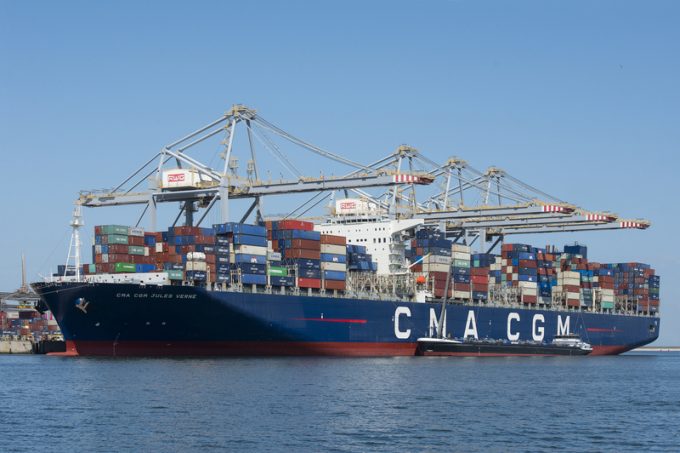Strong Q3 just the tonic to revive Hapag-Lloyd after a weak first half
Soaring freight rates and strong third-quarter demand revived Hapag-Lloyd after a relatively difficult first half, ...
XPO: TOUR DE FORCEBA: SUPPLY IMPACTHLAG: GROWTH PREDICTIONHLAG: US PORTS STRIKE RISKHLAG: STATE OF THE MARKETHLAG: UTILISATIONHLAG: VERY STRONG BALANCE SHEET HLAG: TERMINAL UNIT SHINESHLAG: BULLISH PREPARED REMARKSHLAG: CONF CALLHLAG: CEO ON TRADE RISKAMZN: HAUL LAUNCHCHRW: CASHING INKNIN: IMC DEAL DISCLOSUREDSV: WEAKENINGMFT: TRADING UPDATEBA: SUPPLIER WOES
XPO: TOUR DE FORCEBA: SUPPLY IMPACTHLAG: GROWTH PREDICTIONHLAG: US PORTS STRIKE RISKHLAG: STATE OF THE MARKETHLAG: UTILISATIONHLAG: VERY STRONG BALANCE SHEET HLAG: TERMINAL UNIT SHINESHLAG: BULLISH PREPARED REMARKSHLAG: CONF CALLHLAG: CEO ON TRADE RISKAMZN: HAUL LAUNCHCHRW: CASHING INKNIN: IMC DEAL DISCLOSUREDSV: WEAKENINGMFT: TRADING UPDATEBA: SUPPLIER WOES

Asia-Europe ocean carriers are becoming increasingly concerned that their failure to substantially boost container spot rates this month will result in annual contracts being reset at significantly lower levels.
And, as the start of the Asia-Europe contract negotiating season looms – annual agreements on the trade generally run from January to December – carriers are making a last attempt to jack up prices.
For instance, CMA CGM and Hapag-Lloyd have both restated their Asia-North Europe and Asia-Mediterranean FAK [freight all kinds] GRIs [general rate increases] after the planned 1 November GRIs failed to stick.
Both carriers are seeking the same quantum of minimum rate levels from 1 December as they had planned for this month, and will hope that tighter capacity management will underpin their latest GRI attempts.
Hapag-Lloyd is again looking for a minimum $1,750 per 40ft for North Europe, and $2,250 per 40ft for West Mediterranean ports, while CMA CGM is proposing $1,800 per 40ft for North Europe and $2,000 per 40ft for the West Med.
Meanwhile, Drewry’s WCI Asia-North Europe component edged up slightly last week, with its average rate increasing 4%, to $1,048 per 40ft, while the WCI Mediterranean reading came in at $1,359 per 40ft, up 1% on the week.
However, actual market rates are lower than the averages recorded by the indices, and overall prices remain sub-economic.
“The [1 November] FAK increases are not sticking at all,” said Singapore-based AGX. The collaboration platform for forwarders and importers said larger NVOCCs were discounting to between $800 and $1,000 per 40ft, “often backed by informal discussions with carriers”.
It added: “Quarterly deals at destinations are often closed between $800 and $950 per 40ft, so there is no easy way to push through an increase.”
Indeed, The Loadstar received several unsolicited quotes from Chinese forwarders last week, with one Shenzhen-based company offering $816 per 40ft between Ningbo and Hamburg for mid-November shipment.
Maersk’s liner business slipped into the red in the third quarter, recording an operating loss of $27m, with Q4 results likely to be worse. The Danish carrier has some 68% of its business under contract and, during the Q3 earnings presentation on Friday, CEO Vincent Clerc warned of the “dire” consequences of failing to alter the negative trend of spot rates ahead of long-term contract negotiations.
He said: “Either we see a Q4 that is better than we expect, and that can have a profound impact on what 2024 is going to look like…if Q4 is not delivering some type of improvement, then I think that we are looking at a pretty dire situation in 2024.”
Mr Clerc reiterated that the uncertainty of trading next year was behind Maersk’s decision to cut its workforce by 10% by the early part of 2024. He said: “The big moving factor is the freight rate levels that we will see in 2024.”
And last week, Japanese ocean carrier ONE reported an operating profit of just $58m for the third quarter, its fiscal Q2, while its full-year ebit outlook, ending on 31 March, was stated as being a loss of $191m. This compares with $15bn achieved the previous year.
Comment on this article